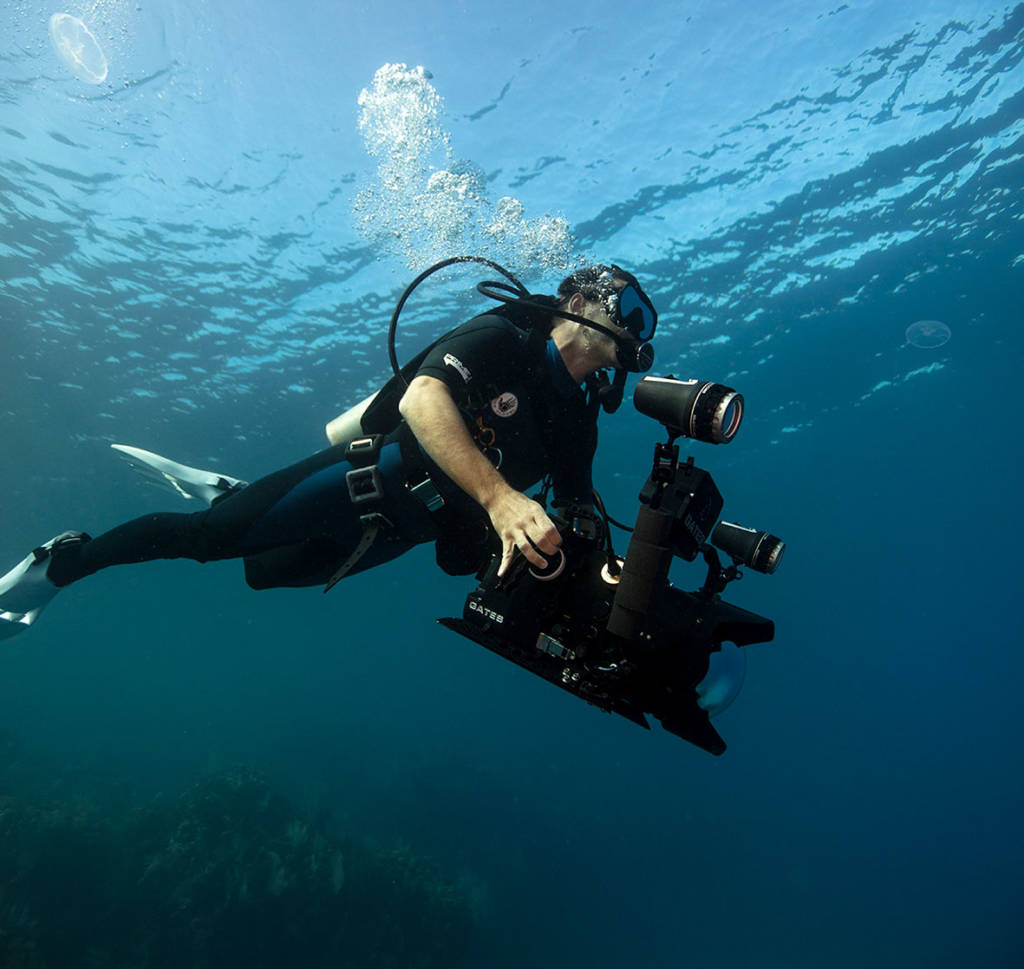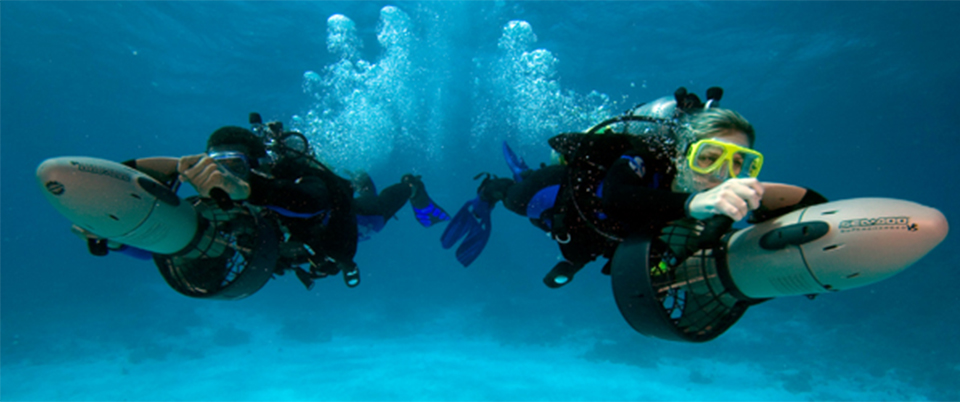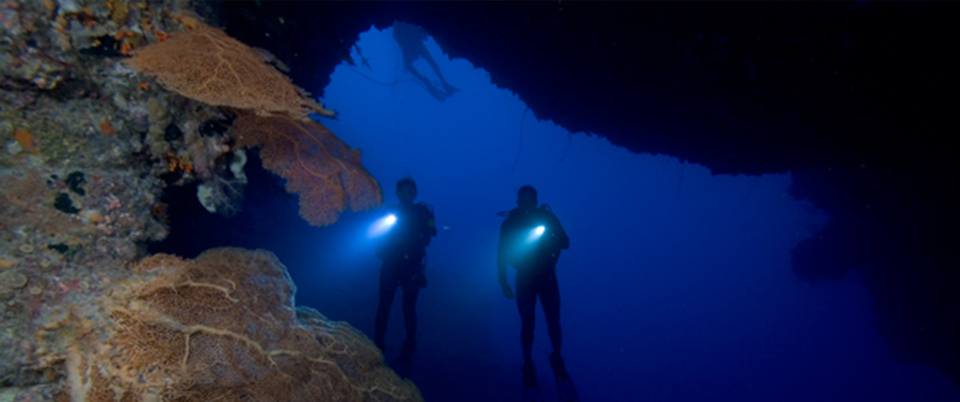PADI Speciality courses
One of the great things about diving is that it is a complex of a large variety of techniques, interest-areas, knowledge and skills. For many that is one of the reasons why it is so interesting to do speciality courses, as there is so much to learn. A speciality course focusses on a specific dive related subject and usually the course length is a matter of days. And that makes these courses not only interesting but also great to do for instance on your holiday.
There are a lot of PADI speciality courses and for each one of these courses you need an entry level, as in what courses and experience do you need to have to enrol into this course. In some cases special equipment is needed that you might want to bring yourself of would prefer Deco Divers to arrange these for you. In the following a list of PADI speciality courses that we can provide in. For any questions or remarks feel free to contact us through this form.
If you already know what specialty you would like to do, than feel free to make a booking and click on the following buttong.
BUTTON BOOKING
Working with divers who are physically or mentally challenged can be quite challenging itself. The awareness of the large variety of abilities that these challenged divers have plus PADI’s adaptive techniques will help an instructor to train and dive with challenged divers.
- To enrol you need to have minimum: PADI Divemaster with and EFR and secondary care course (within past 24 months).
- What you will learn: Becoming aware explore and mindful when introducing challenged people into diving. Additional techniques to motivate challenged divers. Help, guide and direct divers through the steps of the programs that are open to challenged divers.
- Needed equipment: Basic scuba diving equipment.
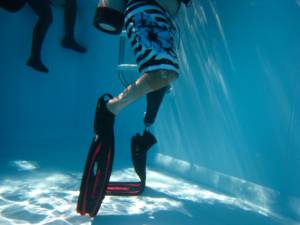
Some love them and others are scared of them; sharks. Many divers would love to dive with sharks at some point in their diving career. But besides their beauty they are a crucial link in the ecosystem. But what is their role in nature? And why is their survival being threatened? Why are their populations declining? And what can we do about it? All interesting questions that are part of this PADI AWARE Shark Conservation Course.
- To enrol you need to have minimum: PADI (Junior) Open Water Diver and be at least 12 years old.
- What you will learn: Why sharks are unique and vulnerable, how the threats to sharks can be managed and what you can do tyo help protect the sharks from extinction.
- Needed equipment: Basic scuba diving equipment.
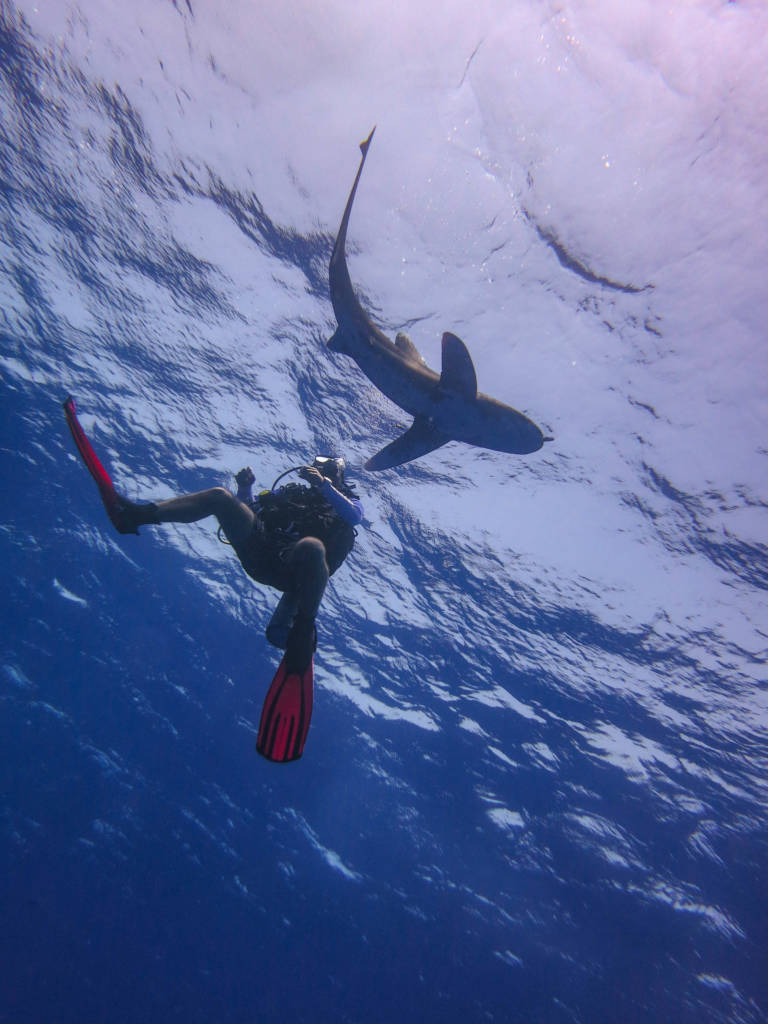
Who would not like to go diving in clear blue waters and wander along reef walls or explore the shallow waters of a lagoon on the inside of a reef? Their colours are amazing, their variety almost endless en most of all these reefs are the home of many animals big and small. But how complex are they and what is their importance for the ecosystem? Are corals plans or animals? The PADI Coral Conservation speciality can be offered as a dry speciality, diving is optional but not needed. Making this a course that everyone can and should take.
- To enrol you need to have minimum: This course is for everybody who has an interest. There are no prerequisites.
- What you will learn: why coral reefs are so important and how they function. Why are so many reefs under threat and what can we do together to preserve the reefs.
- Needed equipment: Basic dive equipment if you opt for the optional dive
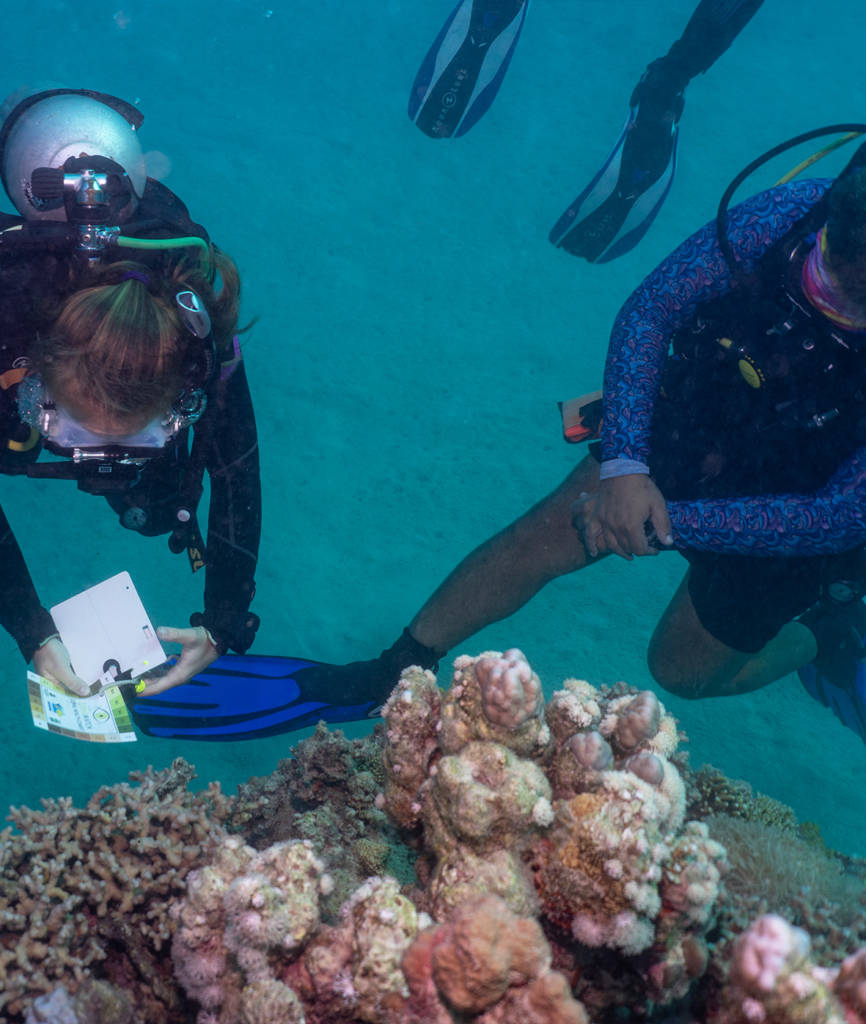
Most of us divers love boats as they bring us to dive sites, make entry into the water easy and provide us with comfort in between dives. In general there are safari boats and daily boats. The daily boat offers dive trips per day with multiple dives. that means you enjoy the diving during the day and be back on land in the afternoon. This is different from safari boats that are floating hotels. These boats offer up to 4 dives a day for multiple days and are also known as liveaboards. Whatever type of boat you prefer, diving from a boat is great and as it is world wide used in most diving activities it can be useful and is interesting to know more about boats.
- To enrol you need to have minimum: If you’re a PADI (Junior) Open Water Diver who is at least 10 years old, you can enrol.
- What you will learn: Boat safety, entry into the water, boat terminology and procedures.
- Needed equipment: Basic scuba diving equipment is required. In addition you might want to bring regular spare parts for your equipment or a surface marker boy (DSMB) to make yourself seen for boats.
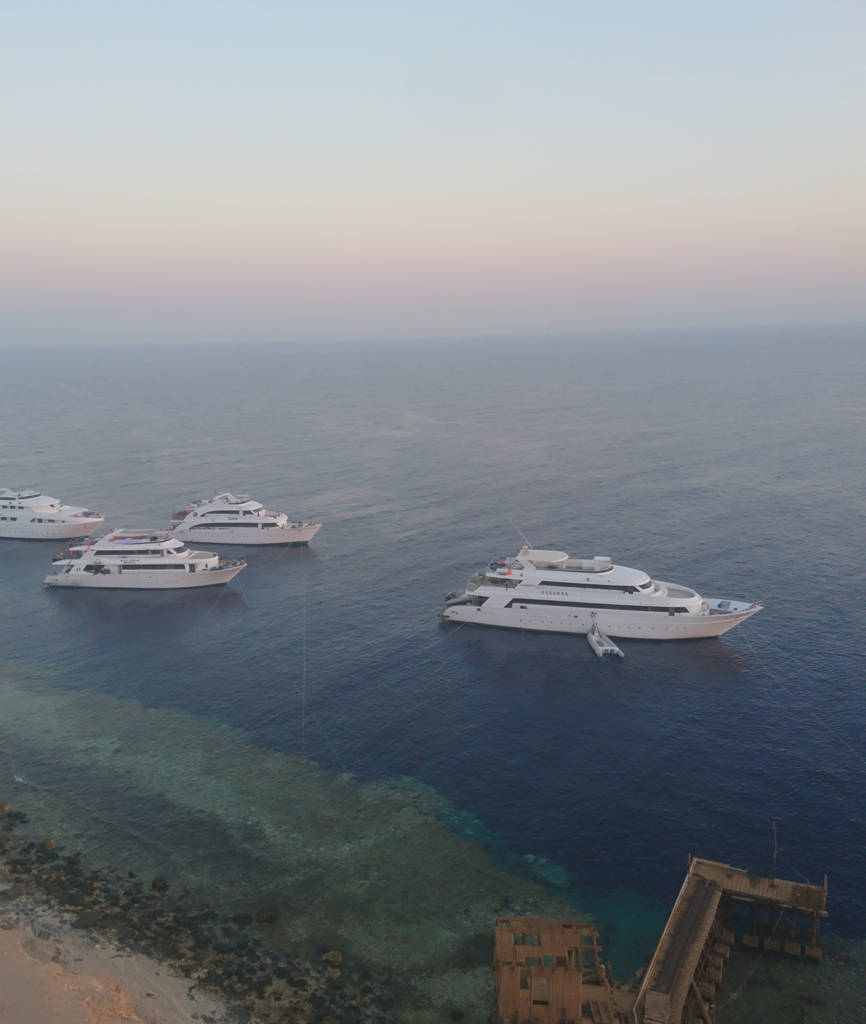
Maybe its for a wreck, a swim-through of sharks, there are many reasons why you would want to dive deeper than the 18 meters for an Open Water Diver or the 30 for PADI Advanced Open Water divers.
- To enrol you need to have minimum: PADI Adventure Diver and minimum 15 years of age.
- What you will learn: how to manage your aior supply, how to plan a deep dive, the buddy contact procedures and so forth.
- Needed equipment: Basic scuba diving equipment including a dive computer, torch, slate and DSMB.
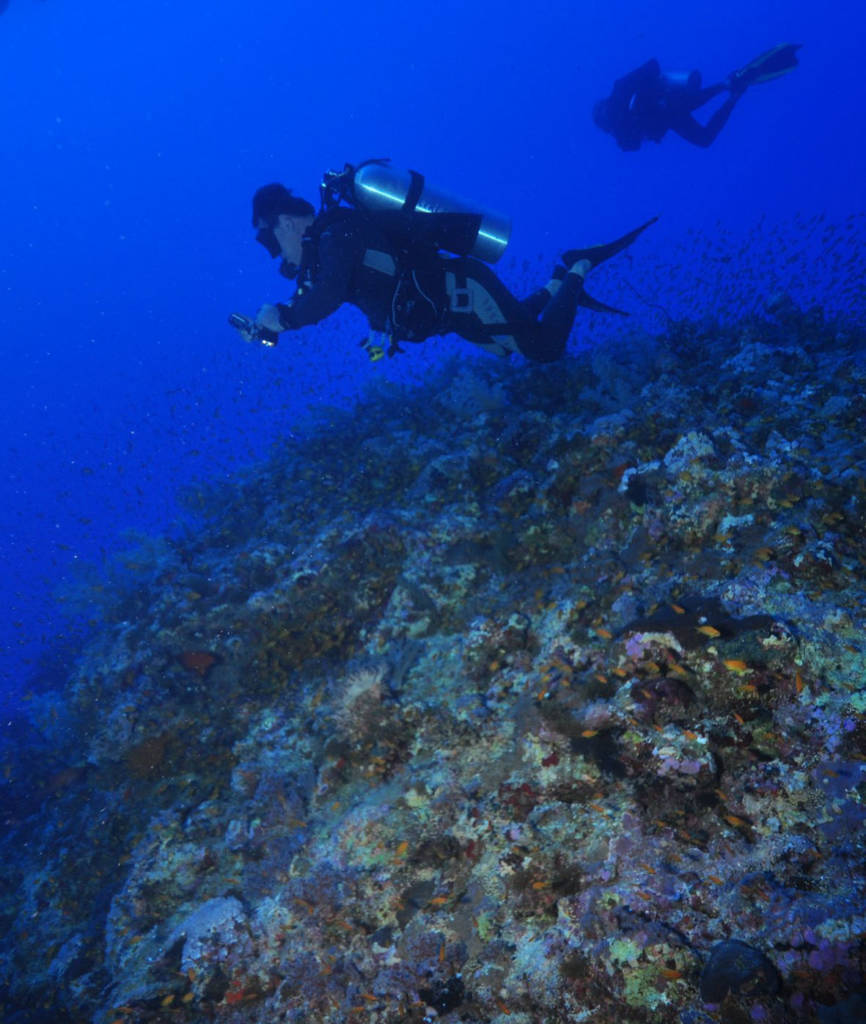
Diving from boats and jumping into a current are 2 reasons for many divers to always take their surface marker buoy on a dive. In many places in the world using the DSMB to end your dive is mandatory. It shows the zodiac drivers where you are and they can approach while you still sit out your safety stop. the use of the buoy is in many destinations not only practical, but diving without is considered dangerous.
- To enrol you need to have minimum: PADI Open Water Diver.
- What you will learn: How to prepare and stow away the buoy before the dive, how to safely launch the DSMB at the end of your dive, what types of DSMBs are there and what are the advantages and dis-advantages of each type?
- Needed equipment: Basic scuba diving equipment and a DSMB.
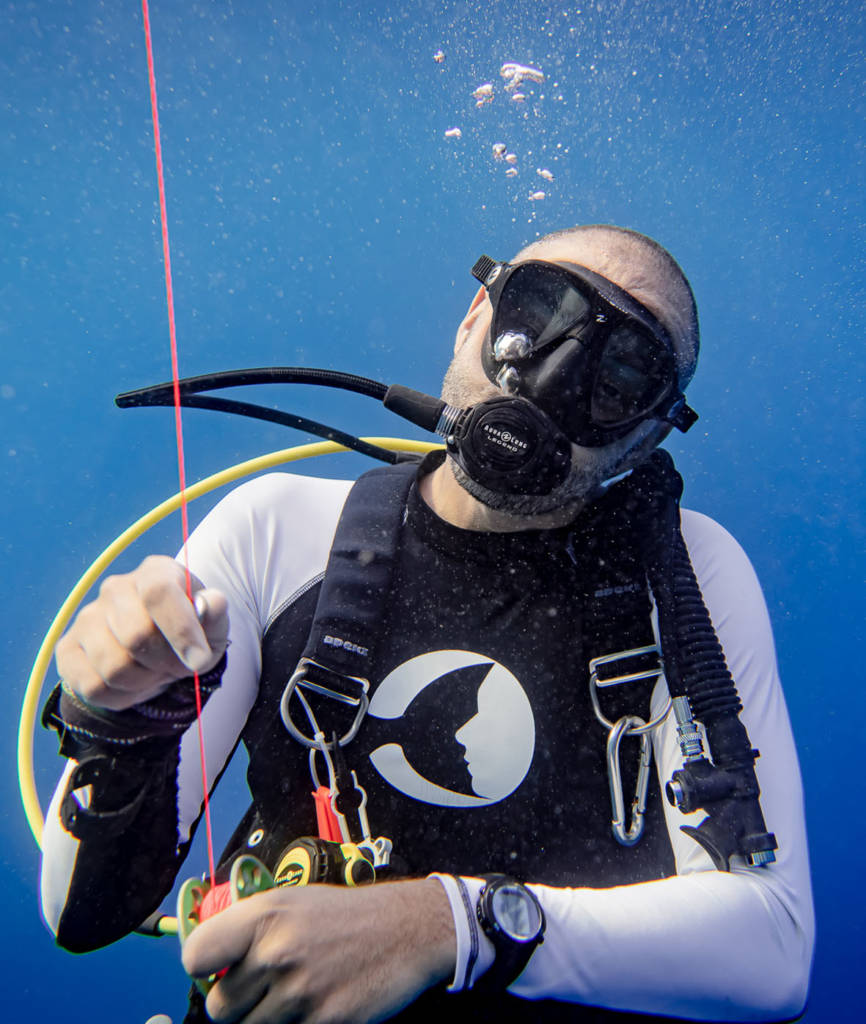
Fly along a reef wall, do a circle around a large wreck or even to help you through a kelp forest, a diver propulsion vehicle can be really convenient and comfortable on a dive as you scoot through the water against current or for a long distance. Besides that its really exciting to drive around on one and a great way to have fun and see a lot on your dive.
- To enrol you need to have minimum: PADI Open Water Diver.
- What you will learn: Different types of DPVS and how to maintain one. How to handle the vehicle under water, planning DPV dives and procedures of how to stay close to your buddy.
- Needed equipment: Basic scuba diving equipment and a DPV (available for rent).
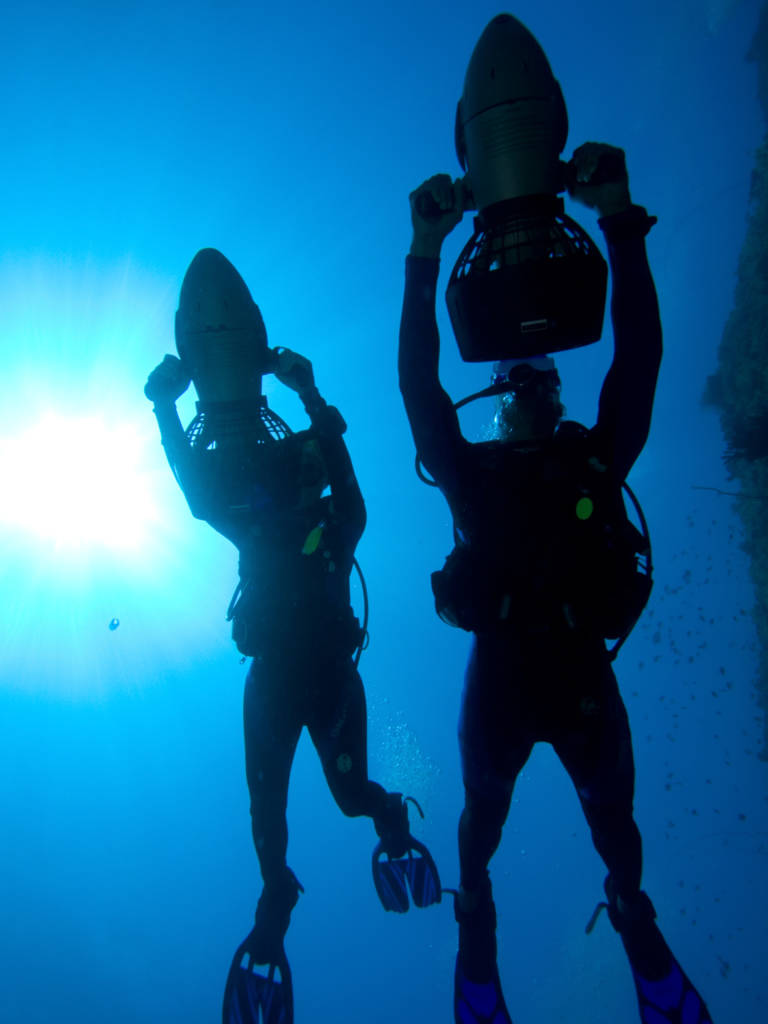
Currents are inevitable as you dive in the sea and often places where a lot of fish life likes to hang out. From big schools of fusiliers hunted by trevallly until sharks that like to hang just off a reef wall. Drifting with a current can be exhilarating but not always as easy as it seems. The currents are stronger than we are, staying close to your buddy or hang comfortably in the current can be challenging.
- To enrol you need to have minimum: PADI Open Water Diver of minimum 12 years.
- What you will learn: what are the causes and effects of aquatic currents. How to handle your buoyancy, how to communicate and keep buddy contact and the additional equipment and procedures needed for a drift dive.
- Needed equipment: basic scuba diving equipment.
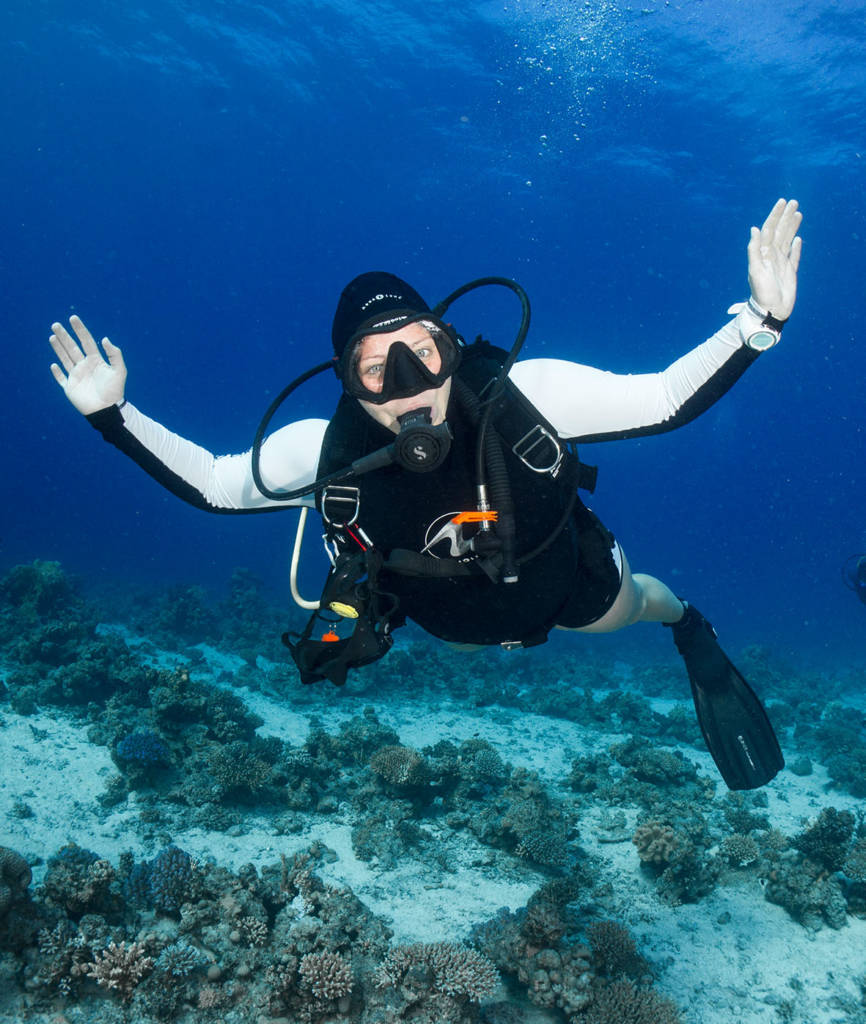
In water we loose energy a lot faster than in air due to the direct contact of our body with the water. By using a dry suit we prevent water from touching our entire body and this saves energy and feels more comfortable in colder water. The suit is connected to our air-supply and during the dive this extra buoyancy device needs to be inflated and deflated. The dry suit is more than just a suit, its a buoyancy device that the diver need to control.
- To enrol you need to have minimum: PADI Open Water Diver and minimal 10 years of age.
- What you will learn: the different types of dry suits, how gear up with a dry suit, how to inflate and deflate while keeping a good buoyancy and how to handle in case of a blow up.
- Needed equipment: Basic scuba diving equipment and a dry suit.
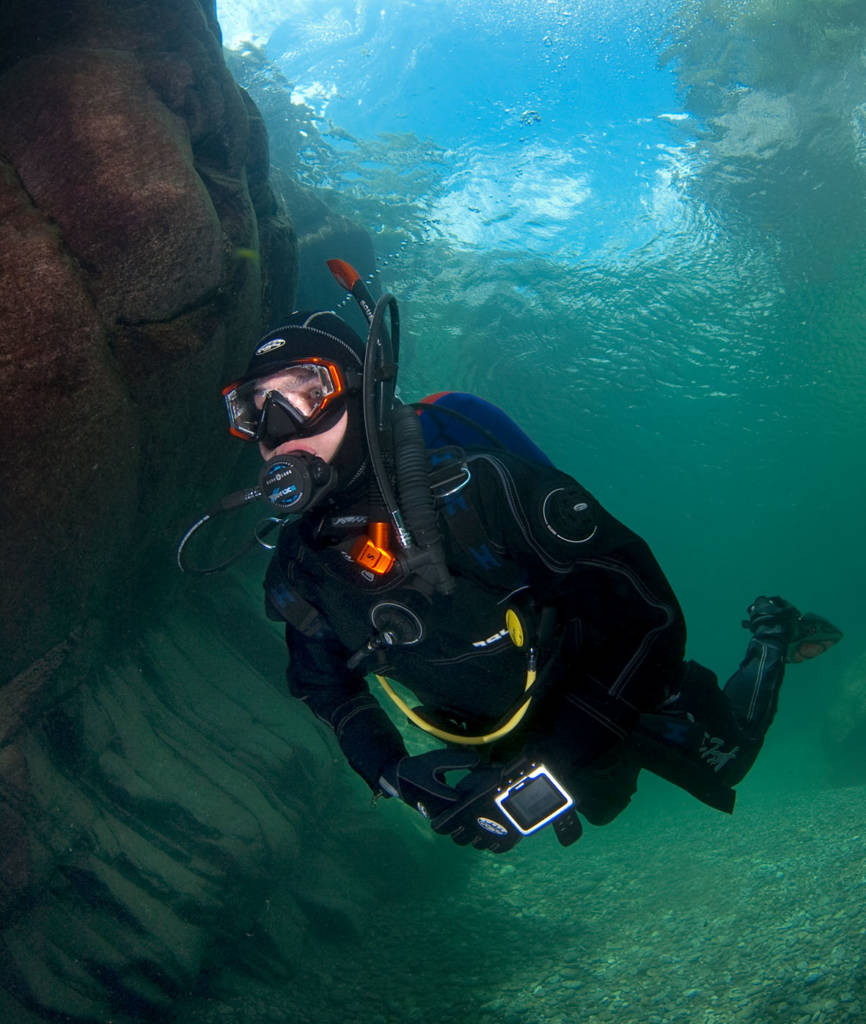
In case of a dive related incident, we always provide oxygen as a first aid measurement. But what illnesses and incidents can a diver encounter? How do you apply oxygen to a victim?
- To enrol you need to be minimum: this course is open to everyone.
- What you will learn: to assemble and disassemble the oxygen equipment, administering oxygen using a variety of masks to a breathing and non breathing diver, and learn what illnesses and incidents requite oxygen treatment.
- Needed equipment: the oxygen training set will be provided by Deco Divers. No other equipment needed.
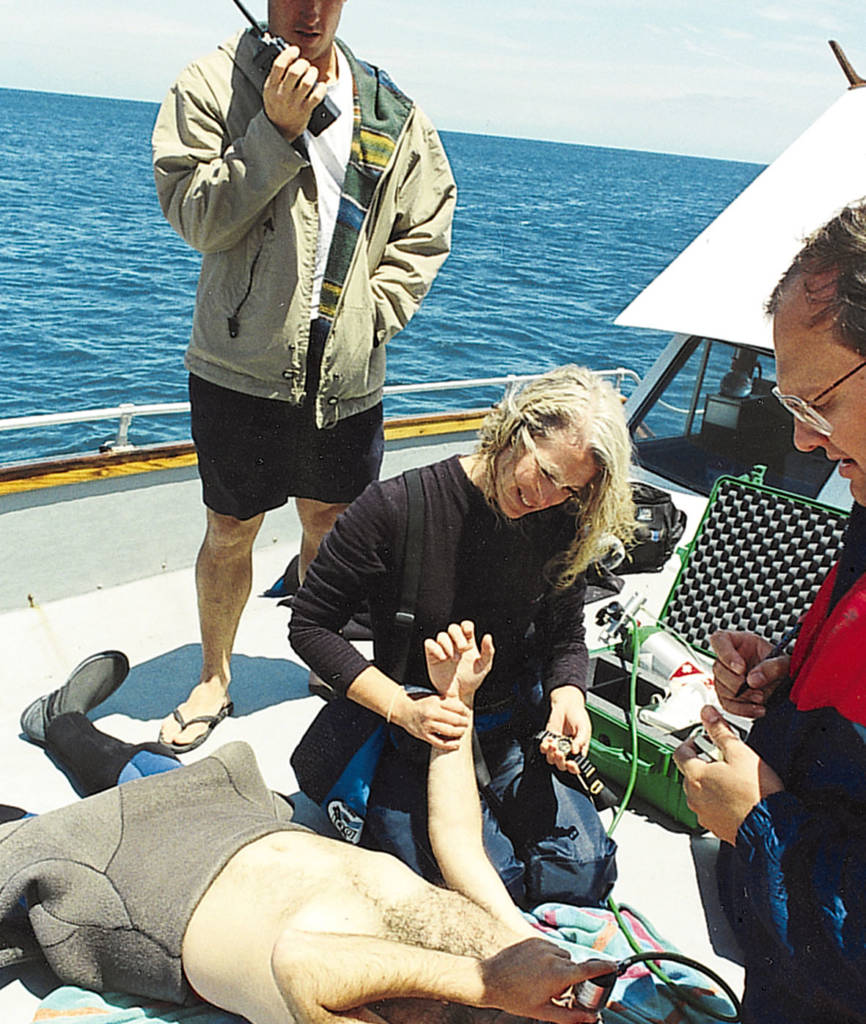
One of the disadvantages of diving with compressed air is the nitrogen building up in your body during the dive. Nitrogen can under certain circumstances generate dive related illnesses that we prefer to prevent. One of the ways to build up less nitrogen is by having less nitrogen in your breathing gas, by replacing it with oxygen. This gas mix is known as nitrox and a diver using it is called a Nitrox diver or and Enriched Air Diver. Diving with Nitrox has quite a bit of advantages, but as all things also brings another risk. One of the biggest advantages is that a nitrox diver can stay longer at depth than an air diver as long as the depth is not to deep and there is enough breathing gas. So basically diving with nitrox within the limits makes diving safer and gives you the option to dive longer and what diver would not like to have that option?
- To enrol you need to be minimum: PADI Open Water diver of 12 years or older.
- What you will learn: what dive related illnesses are there when it comes down to nitrogen and oxygen use. To what depth can you dive with nitrox and how long can you stay there? What is oxygen exposure and partial oxygen pressure and how to manage them.
- Needed equipment: this is a dry PADI speciality, diving with the Nitrox is optional in which case you will need basic scuba diving equipment.
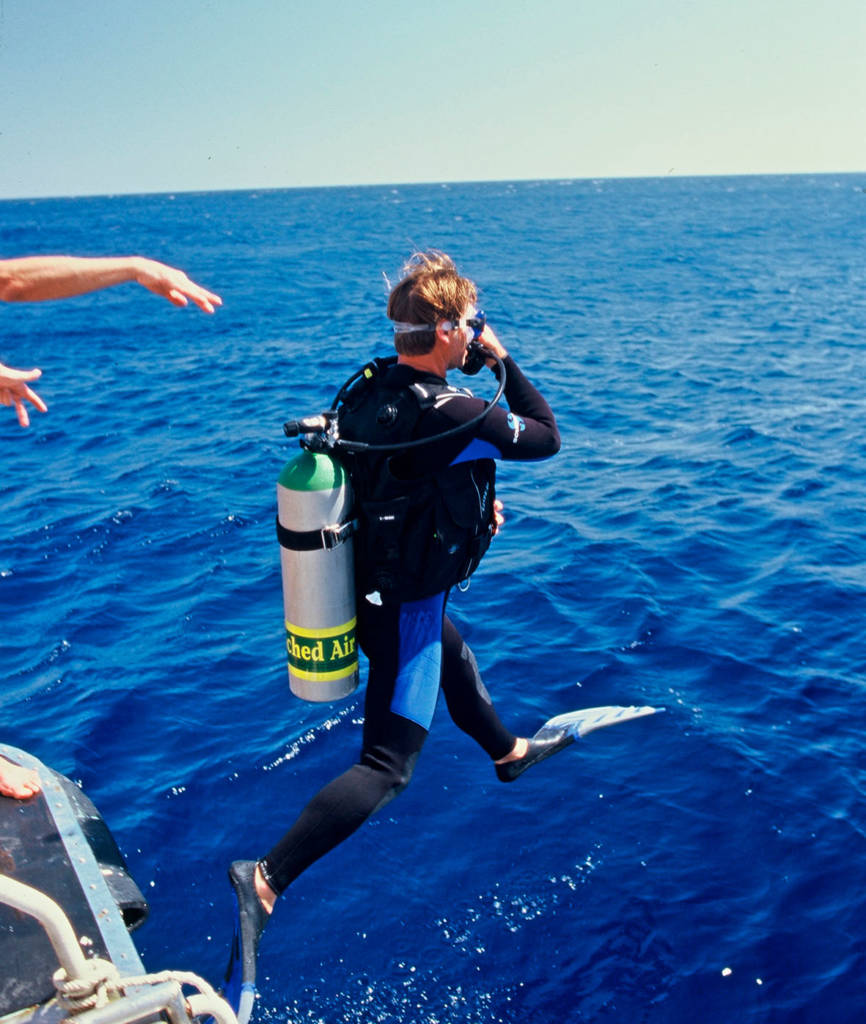
Unfortunately things break and need maintenance before it can be used again, especially scuba dive equipment. Don’t miss a dive because of some minor equipment failure, but learn what to bring as you go diving and how to fix minor problems.
- To enrol you need to be minimum: PADI Open Water Diver and minimum 10 years of age.
- What you will learn: Routine care and maintenance procedures of dive equipment, how to overcome common equipment failure and understanding what caused this failure. Know what spare parts you should bring as you go diving and when to bring broken equipment to a professional.
- Needed equipment: your instructor may ask you to bring your scuba equipment.
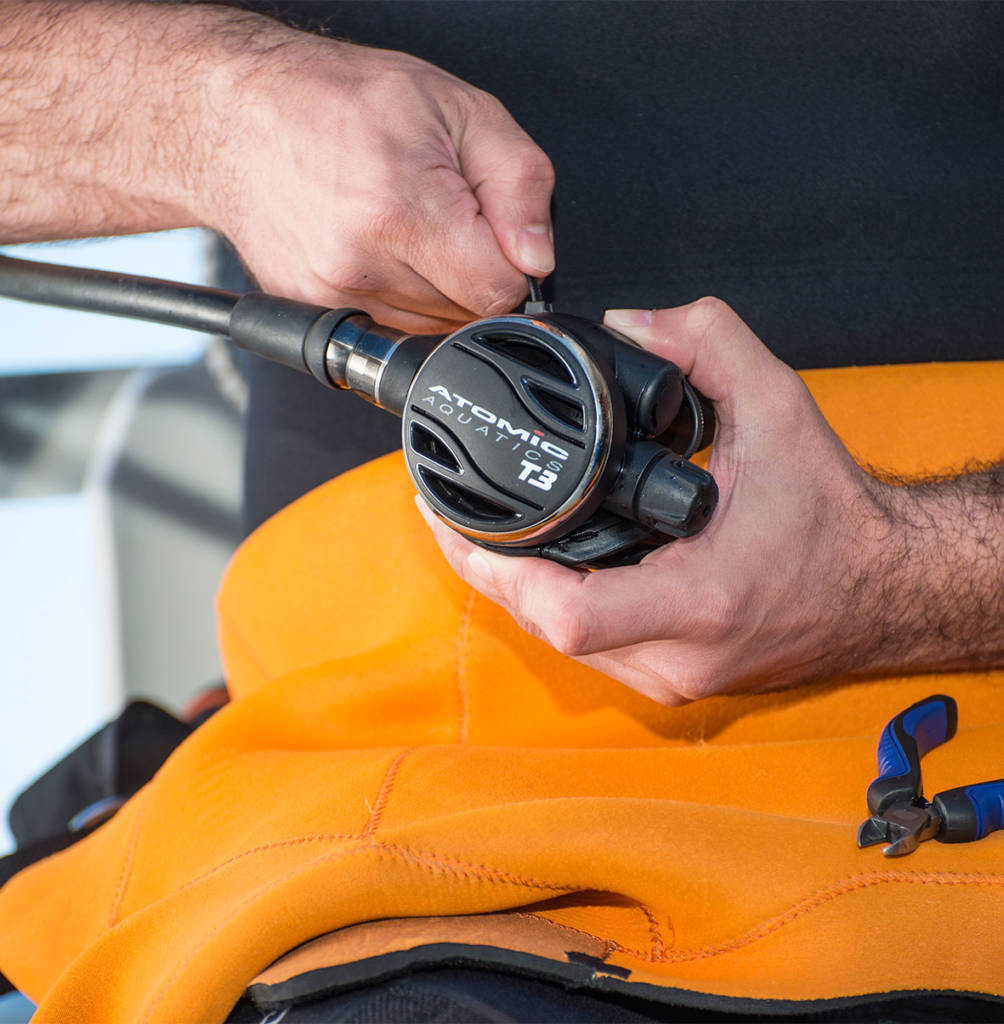
A common question that we hear after a dive is ‘what was that fish?‘ There are over 25.000 known species and they all have their own habitat, eating preferences, way they interact with other fish and so forth. Knowing all these species by heart would be awesome but an almost impossible task. Instead we use a system of determination to identify the fish families and their habits. Its a great skill to master as it will enlarge your enjoyment and understanding of marine life and is often done in combination with photography and videography.
- To enrol you need to have minimum: PADI Open Water Diver and minimum 10 years of age.
- What you will learn: How to determine fish, learn common species, survey techniques and procedures, and learn about project AWARE and how we can all help protect marine life.
- Needed equipment: Basic scuba diving equipment plus a slate.
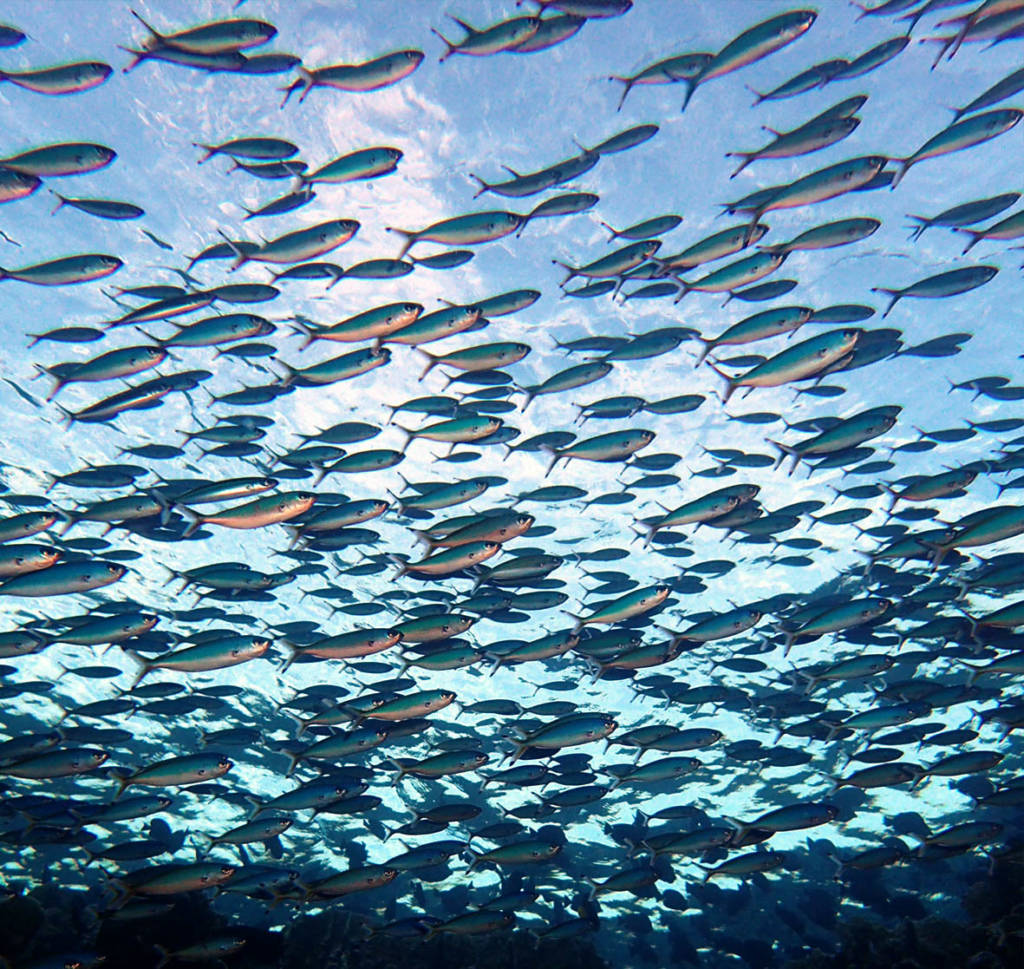
After the sun sets, life on the reefs change. Some species go in the reef to find a place to rest for the night. Other species come out of the reef to feed during the night. Marine life is quite different on a night dive in comparison to a day dive. Morays and ray species hunting, Spanish dancers out in the open en crabs coming out of their corals can only be seen at night. the lack of sunlight is great, but can also be a bit disorientating as we are in the dark. Making a night-dive is both exciting and relaxing and for sure something that most divers want to learn to do.
- To enrol you need to have minimum: PADO Open Water Diver that is minimum 12 years old.
- What you will learn: Communication techniques including handling of lights. Entering the water, navigate on the dive and exit while its dark. Understand how behaviour of marine life is different in the night, compared to the day.
- Needed equipment: Basic scuba diving equipment plus a torch.
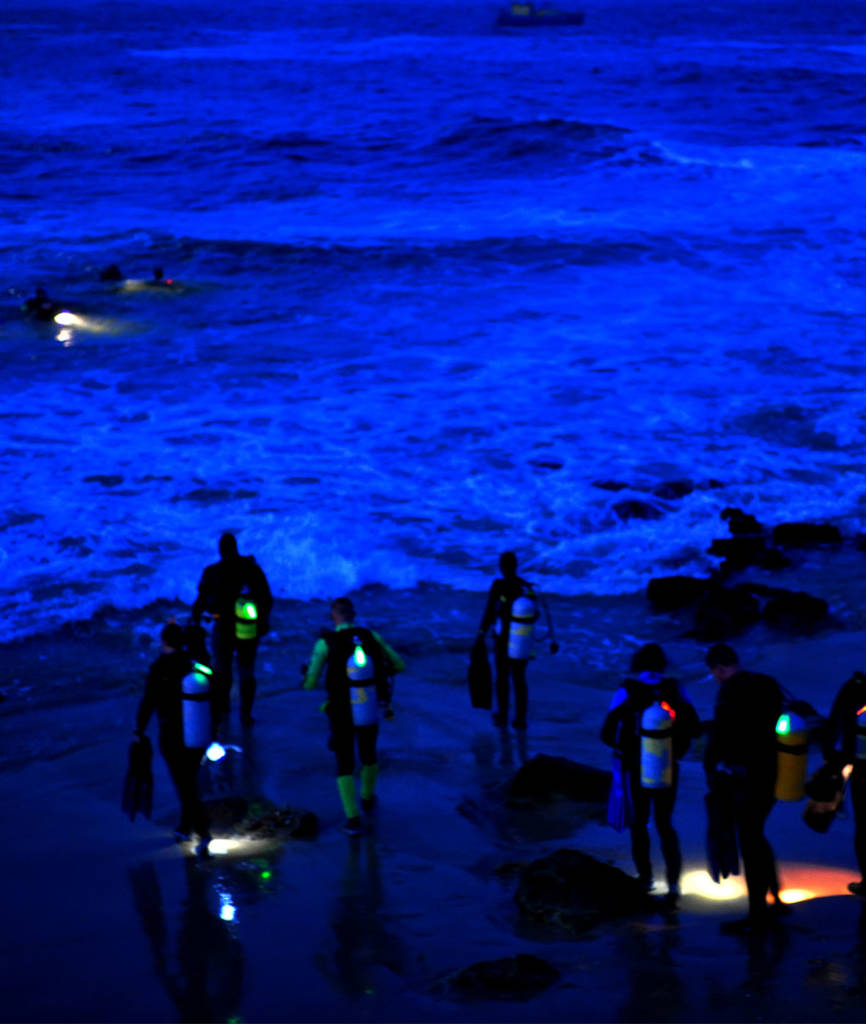
Some divers look like they are part of the water. They float around effortless, don‘t touch anything in their surroundings and are very relaxed. It not only looks great but it saves a lot of energy and for sure is good for a low air-consumption. Some divers were born with a talent for a perfect buoyancy, but most of us actually have to put an effort in to learn it.
- To enrol you need to have minimum: PADI Open Water Diver and minimum 10 years.
- What you will learn: determine exactly how much weight is perfect for you on a dive and what trim system suits you best. How to streamline your equipment en how to hoover in place both vertically as horizontally.
- Needed equipment: Basic scuba diving equipment.
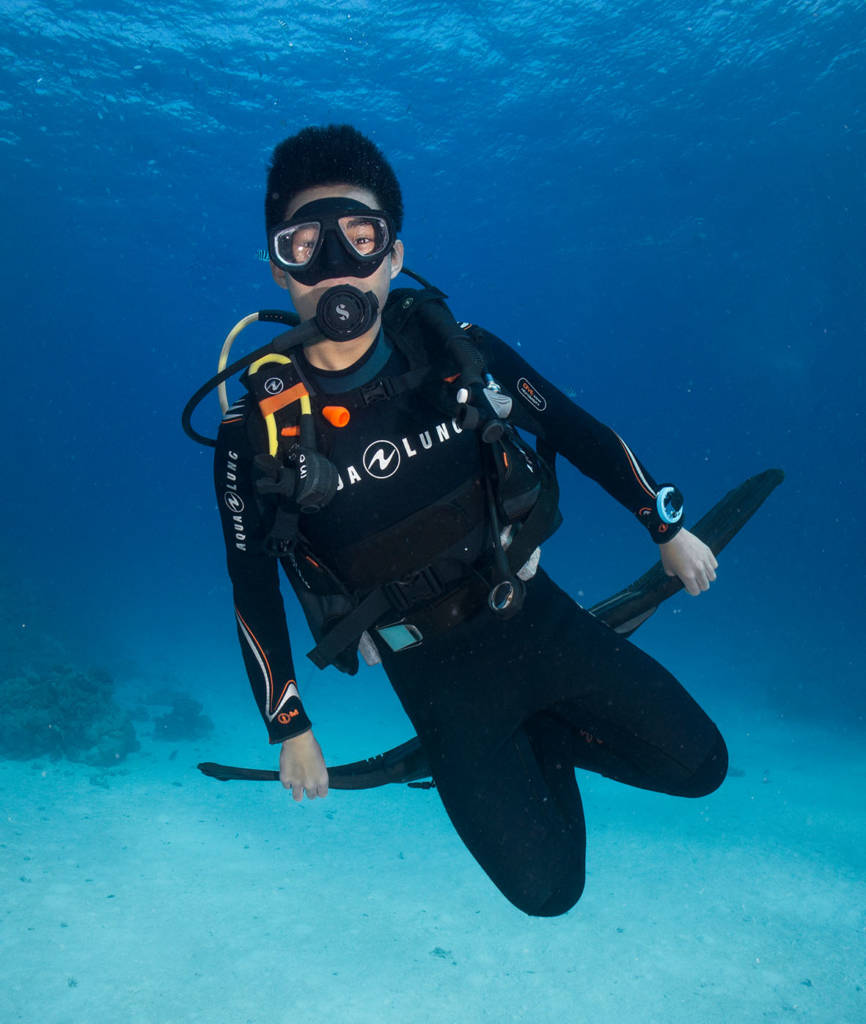
Project AWARE is a global movement of divers and non-divers for ocean protection. If you want to make a difference especially when you dive or the next time you travel, and the health of the oceans is important to you, than this is a speciality to do.
- To enrol you need to have minimum: This course is open to everybody.
- What you will learn: Project AWARE as a global movement. The ten tips for divers to protect the ocean and a personal plan of action of how you can help to make a difference.
- Needed equipment: none unless we combine it with a dive.
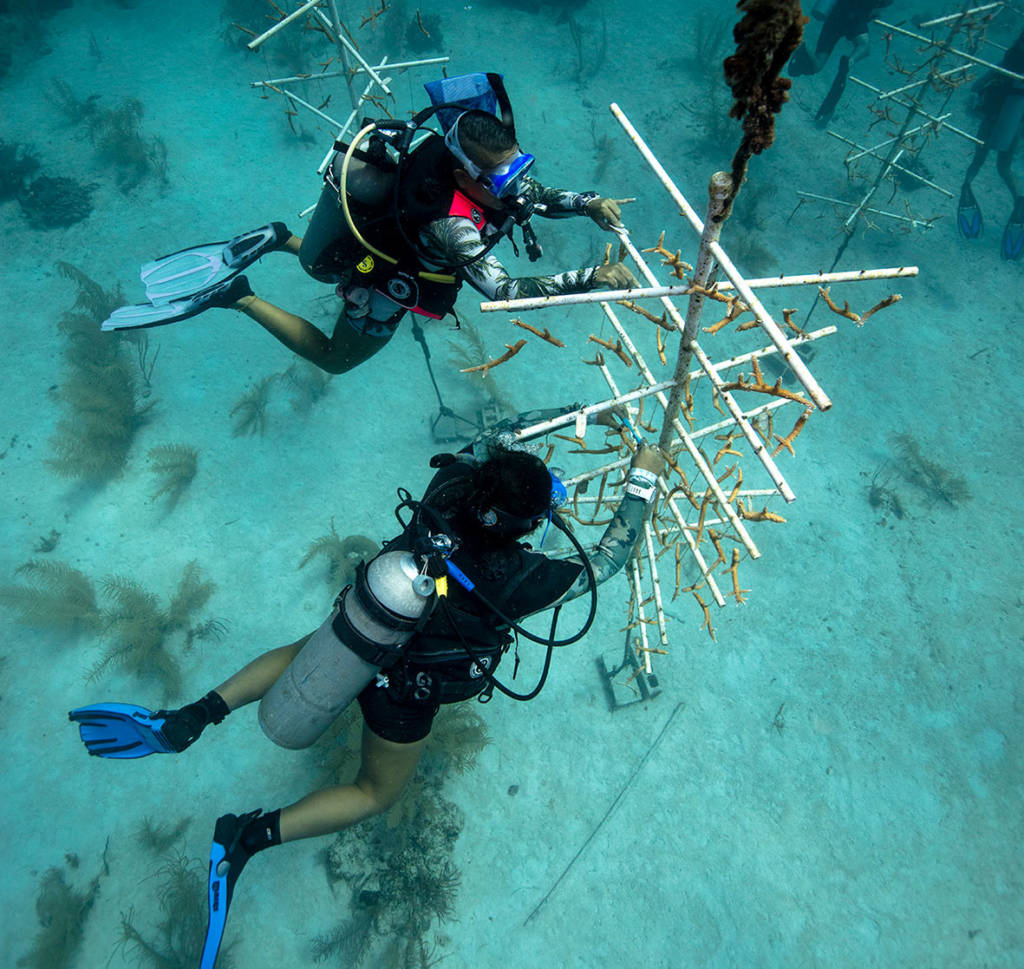
Sometimes things fall overboard or get lost on a dive and sometimes you need to retrieve what was lost. Visibility is not endless underwater, especially when we are searching for a lost item. Using efficient search techniques involving navigation and buoyancy skills in cooperation with your buddy is not only interesting but also a lot of fun to practice.
- To enrol you need to have minimum: PADI Advanced Open Water Diver (minimum 12 years old) or PADI Open Water Diver + PADI Underwater Navigator.
- What you will learn: Search paterns by using compass or natural navigation, finding large objects and using a lifting bag and other recovery techniques.
- Needed equipment: Basic scuba diving equipment.
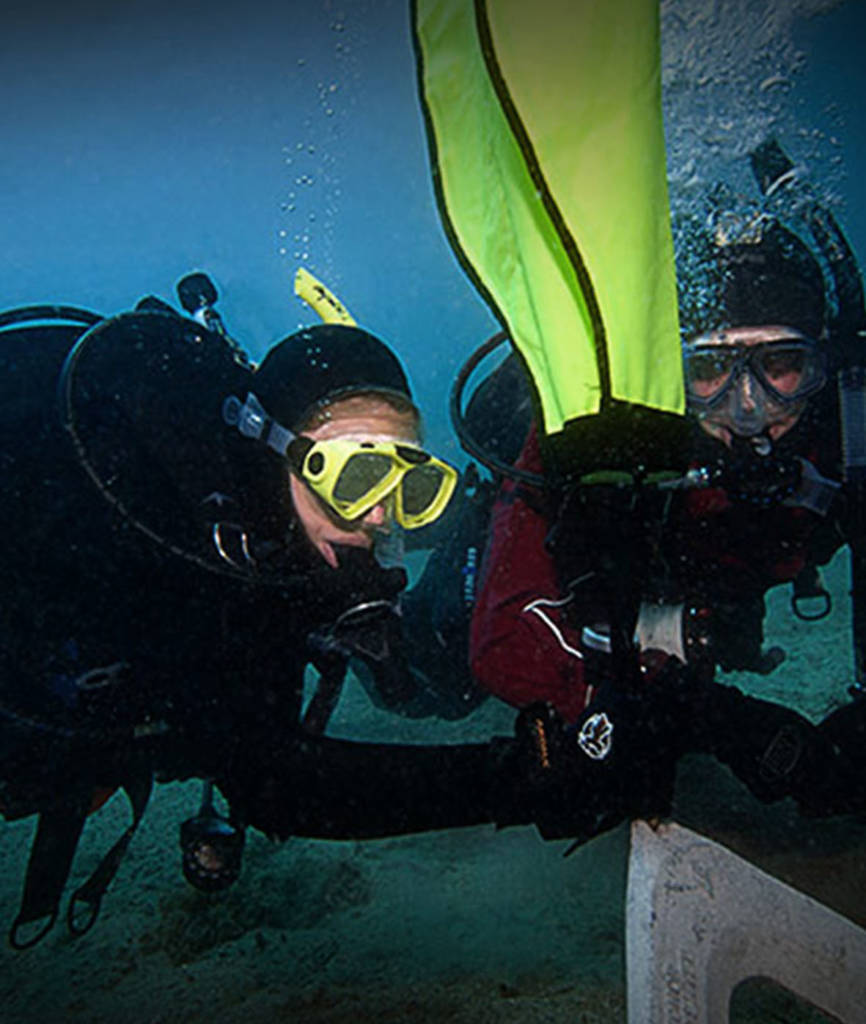
We all learn to dive together with a buddy, however as an experienced diver you might encounter moments where diving without a buddy is the better solution. In such cases acting responsibly, bringing enough equipment, following proper procedures are a must if you decide to make a self reliant dive. And if planned and conducted thoroughly with the correct mindset and equipment it safe and is quite exciting. This type of diving is not for everybody but if you are willing to accept a certain risk and want to depend on yourself, that the PADI Self-Reliant Diver is the good way to go.
- To enrol you need to have minimum: PADI Open Water Diver (Minimum 18 years old) + 100 logged dives.
- What you will learn: Proper dive planning using air consumption rate calculations, life support system redundancy, and independent management of dive emergencies. Gas-rate swims, gas-switch procedures, navigation and DSMB procedures.
- Needed equipment: Basic scuba equipment plus DSMB, redundant gas-supply, redundant computer and redundant signalling device.
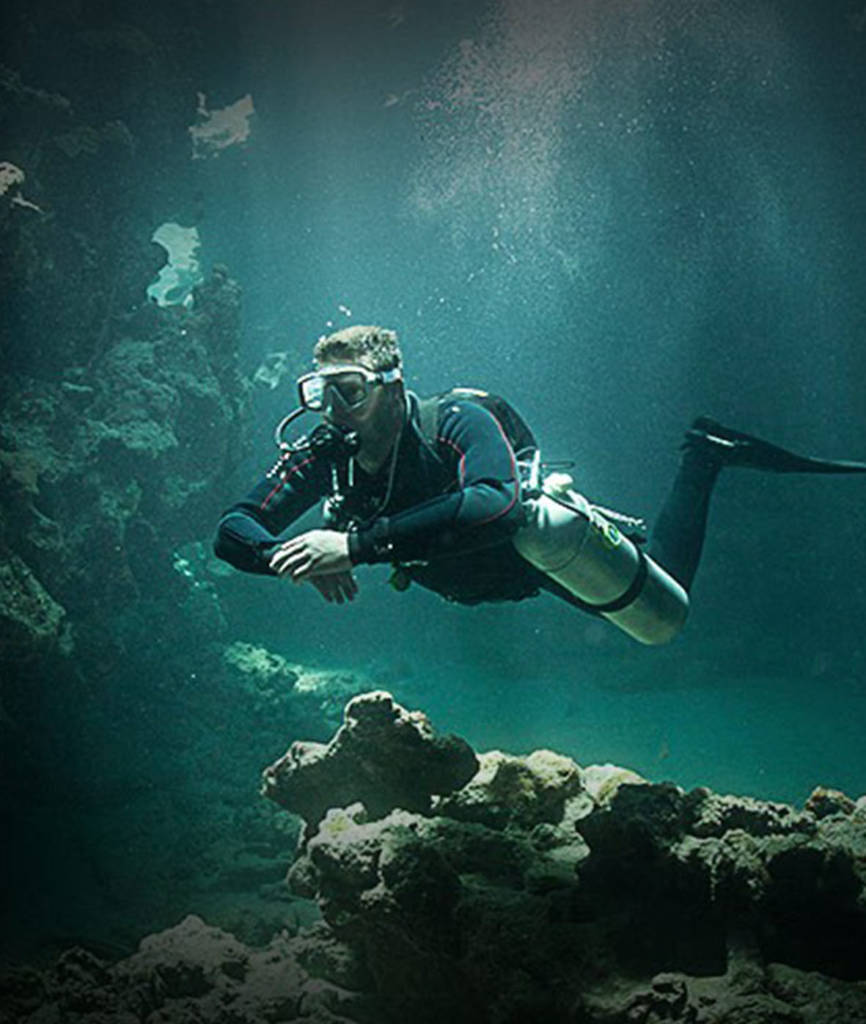
Traditionally we wear our tanks on our backs. An Alternative technique is to wear them alongside during a dive as sidemount divers do. By carrying the tanks on the side you are more flexible in your streamlining and if gives you more flexibility in your movements. Plus as you enter or exit the water you do not carry your tank on our back. You just clip them on or off and you hand over and step out.
- To enrol you need to have minimum: PADI Open Water Diver (Minimum 15 years of age)
- What you will learn: The assembly of sidemount scuba diving equipment. To trim the weight-set and sidemount for a perfect balance underwater. And if wearing 2 sidemounts you will do a gas-switch between stages as planned. Follow emergency procedures as diving with sidemounts.
- Needed equipment: Sidemount diving gear
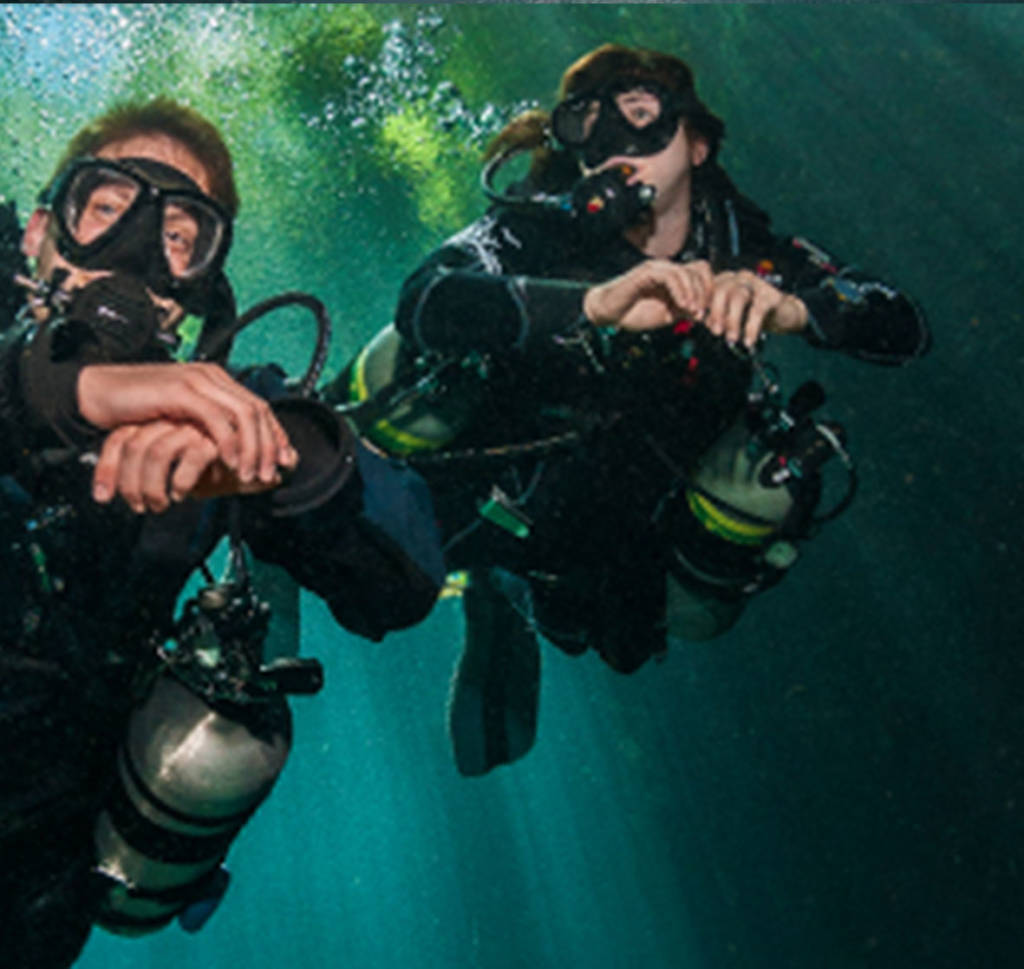
Looking for the special wonders on a reef or dive site for photography or just because you love it? Than learn about symbioses, ecology, and aquatic plant and animal habitats to open your eyes. Knowing what lives on what, what eats what and much more will help you find things you did not notice before. Making this speciality an eye-opener for divers in more ways than one.
- To enrol you need to have minimum: PADI Open Water Diver (Minimal 10 years old).
- What you will learn: About ways in which animals and plants live together as in symbioses, ecology, habitat and behaviour. The key differences between the terrestrial and aquatic worlds. And responsible ways to interact with marine life.
- Needed equipment: Basic scuba equipment.
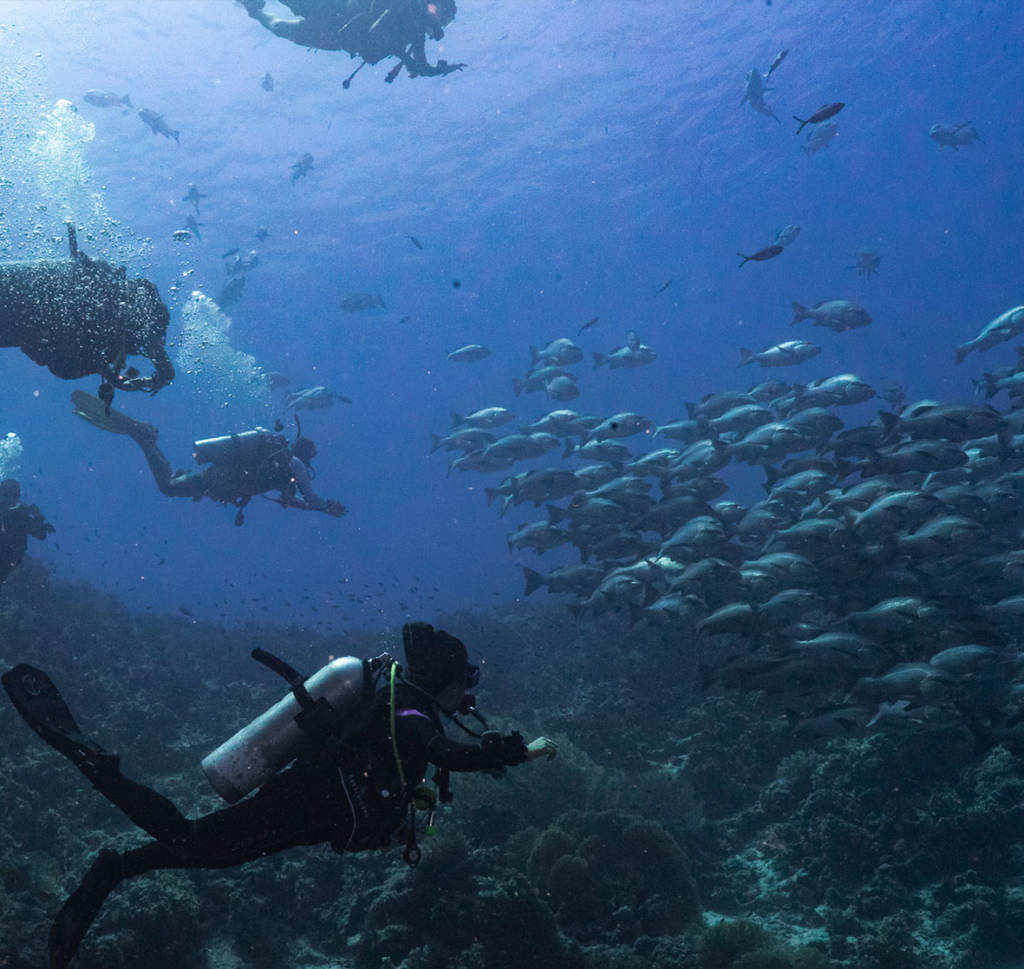
Doing the navigation on a dive and having others following you can be quite the responsibility. By using your knowledge of the dive site, sometimes the currents or how the light falls into the water and of course a compass navigation becomes easier. Knowing where you are and how to get back is good knowledge to have on every dive,
- To enrol you need to have minimum: PADI Open Water Diver (minimum 10 years of age).
- What you will learn: How to estimate distance under water. A compass navigation with at least 5 turns. How to make maps under water. And Marking / relocating an underwater object from the surface.
- Needed equipment: Basic scuba diving equipment.
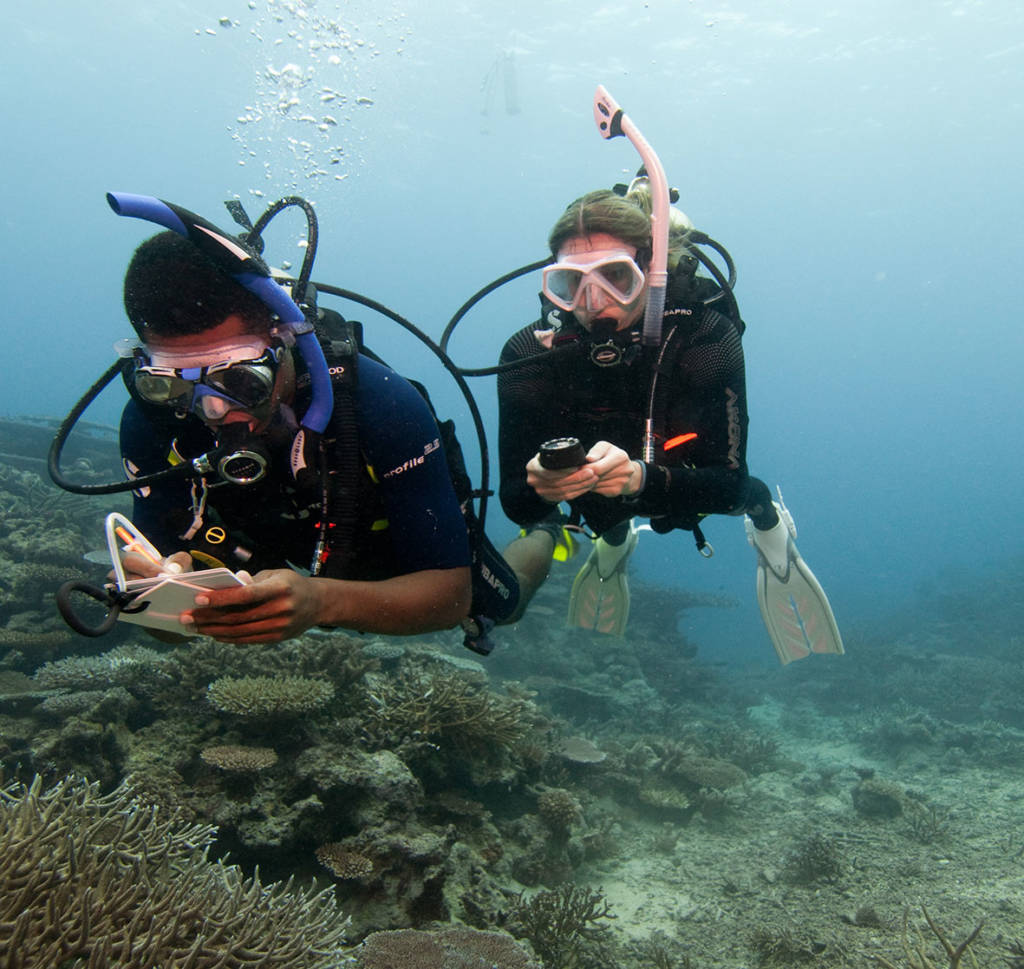
The wonders of the underwater world, stunning corals, big shoals of fish, a shark passing by or a wreck that you swim through.In these digital ages more than half of the divers bring a camera with them on a dive. But making a great shot is not as easy as it looks! Keeping your buoyancy under control while you handle the camera, a subject (the fish you want to shoot) that is likely to be on the move, currents that play their parts and more can be quite a challenge. All and all not an easy task to make a great picture as there as so many elements in play.
- To enrol you need to have minimum: PADI open Water Diver (minimal 10 years old).
- What you will learn: What different types of cameras are there and what set up would be good for you? What is the PADI SEA (shoot-examine-adjust)) method? What composition and light do for a great picture.
- Needed equipment: Basic scuba diving equipment plus suitable camera.
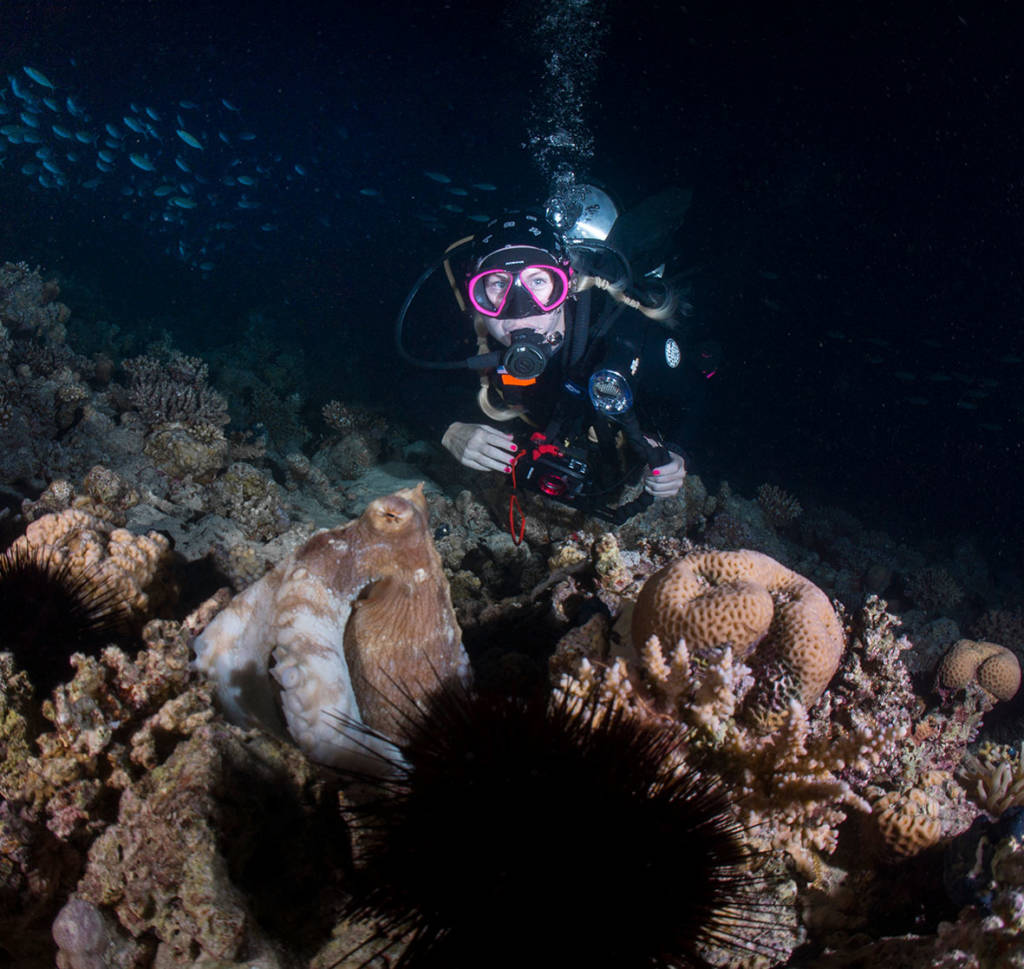
The digital era is here. even in the underwater world, as more and more divers bring cameras. Making videos of all elements of the dive, from how to get into the water until a fish in a cleaning station or a buddy with funny moves. But from making a shot until you make a nice movie that you watch over and over again are quite some steps in between. Sights, sounds and motions captured in one video experience asks of the videographer to adjust, cut and edit his shots and combine that with some catchy song.
- To enrol you need to have minimum: ADI Open Water Diver (minimum 10 years of age).
- What you will learn: how to select video equipment. What is exposure, focus, story line and sequencing. And how to edit it all together into one movie.
- Needed equipment: Basic scuba diving equipment plus an underwater video camera.
